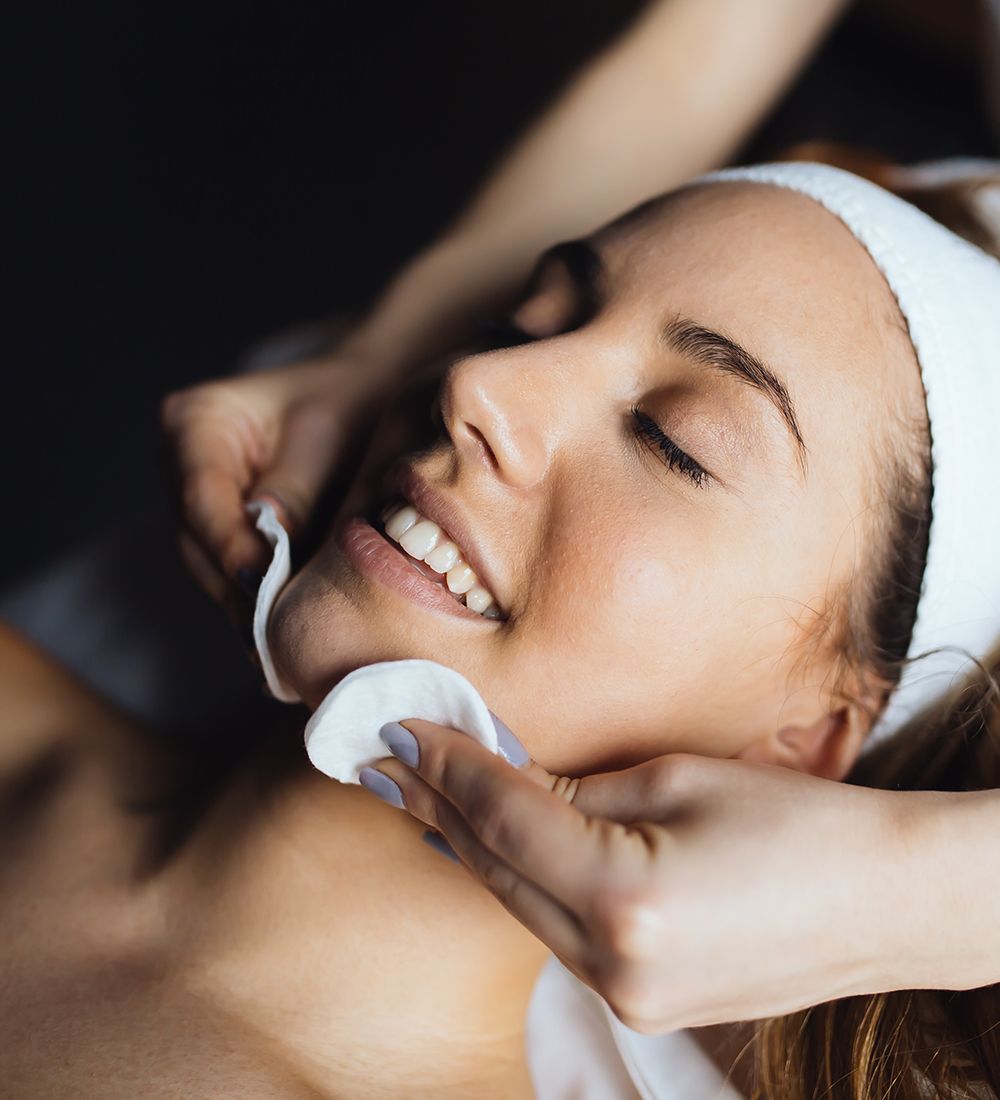
The four Wide Legged Standing Forward Bend Postures, also known as Prasārita Pādottānāsana A-D, are the first wide leg stretches we see in the Ashtanga Yoga standing sequence. They are wonderful postures to practice in order to gain greater proprioception, balance, flexibility. These asanas are always awesome opportunities to really work with gravity to hold your spine in space as you move from posture to posture.
If you would like to practice along to our FREE Yoga tutorial on Prasarita Padottanasana A-D, tap HERE
Prasarita Padottanasana A-D are the seventh through eleventh poses in the Ashtanga Yoga standing sequence. They come right after Parivrtta Parsva Konasana, or revolved side angle posture.
In this step-by-step guide, we will explore Prasarita Padottanasana A-D with the correct Sanskrit vinyasa count to help you master this invigorating pose.
Benefits The Benefits of Prasarita Padottanasana A-D:
Prasarita Padottanasana A-D are popular standing yoga poses that offers numerous benefits for the body, mind, and spirit. These postures involve standing with the legs wide apart and folding forward from the hips, bringing the torso towards the ground.
- Stretches and Strengthens the Lower Body
- Promotes a Healthy Spine
- Calms the Mind and Relieves Stress
- Improves Digestion
- Enhances Balance and Proprioception
- Energizes the Body
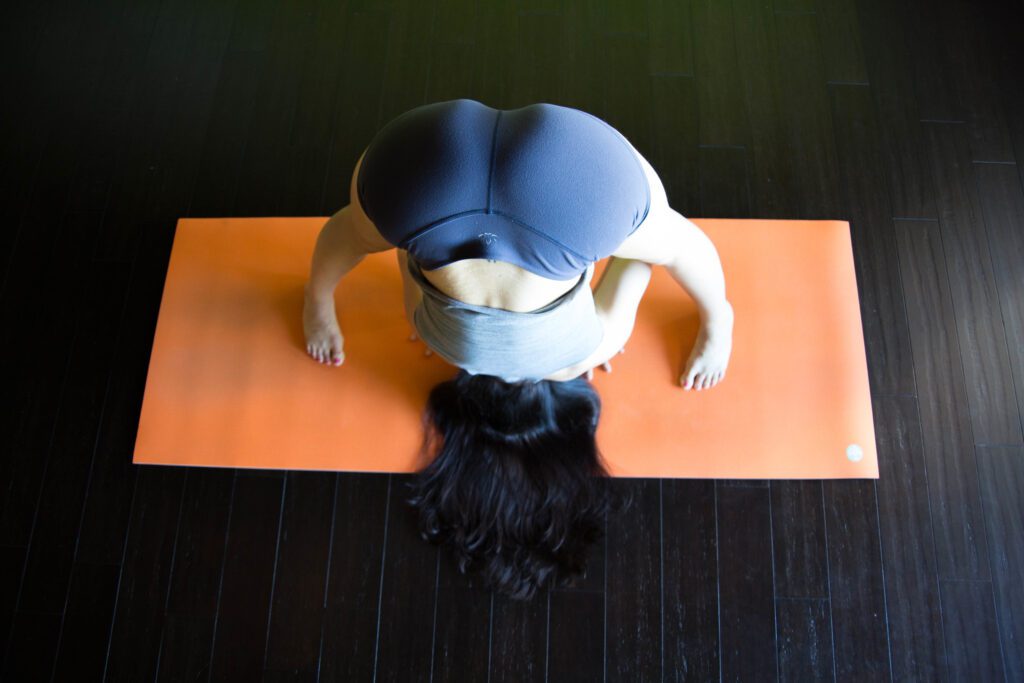
Contraindications:
While Prasarita Padottanasana offers numerous benefits, it may not be suitable for everyone. It’s important to practice this pose mindfully and with awareness of your body’s limitations. Here are some contraindications to keep in mind:
- High Blood Pressure: If you have high blood pressure, it’s important to be cautious with inversions like Prasarita Padottanasana, as it can potentially increase blood pressure further. It’s best to practice this pose with the guidance of an experienced yoga teacher or avoid it altogether if you have uncontrolled high blood pressure.
- Lower Back or Neck Injuries: If you have a history of lower back or neck injuries, it’s essential to approach Prasarita Padottanasana with caution. Avoid rounding the back excessively or putting strain on the neck. Modify the pose by keeping the spine straight and using props like blocks or a bolster for support.
- Hip or Hamstring Injuries: If you have an acute or chronic hip or hamstring injury, it’s important to avoid deep forward folds in Prasarita Padottanasana. Focus on keeping the legs straight without overstretching the muscles or exacerbating the injury. Again, using props like blocks can be helpful.
Step By Step Instructions for Prasarita Padottanasana A-D
Prasarita Padottanasana A
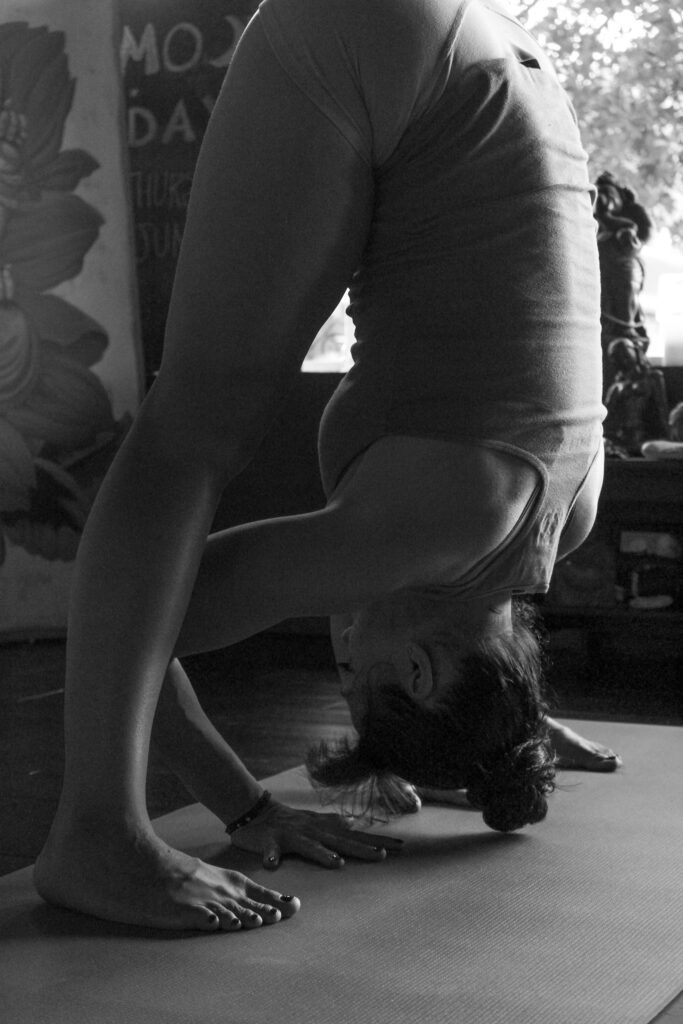
Standing at the top of your mat in Samasthiti (equal standing posture)
Ekam (Inhale) Step or Jump Your Feet 4-5 feet apart, hands to hips, head up.
Dve (Exhale) Fold forward with a flat back, placing both hands on the ground in line with your feet. Look up. Again inhale lengthening your spine, looking upward. Keep your feet parallel to each other and ensure that your toes are pointing straight ahead.
Trini (Exhale) Pressing your hand down and forward into the floor, fold forward. Root down through the four corners of your feet, pressing down and out through the feet to engage your glutes to help support your body. Stay here five deep breaths. Engage mula bandha with each inhale. Gazing towards your nose (Nasagrai Drishti).
Chaturi (Inhale) Straighten your arms and look forward. Exhale here.
Pancha (Inhale) Place your hands to your hips and inhale back to standing. Be sure you press your hips forward and allowing your weight to stack naturally through space to return to standing. Exhale there.
Prasarita Padottanasana B

Ekam (Inhale) With your feet still 4-5 feet apart and parallel, inhale and take your arms up and out to the sides.
Dve (Exhale) Place your hands to your hips and engage your mid back to keep your chest lifted. Head up. Again inhale and lengthen your spine, being sure to keep your ribs down as you press your chest up.
Trini (Exhale) With both hands on your hips, hinge from your hips to fold forward. Stay here five deep breaths. Actively engage your mid back to keep your chest open in this forward bend, while keeping your hands to your hips. Root down through the four corners of your feet, pressing down and out through the feet to engage your glutes to help support your body. Engage mula bandha with each inhale. Gazing towards your nose (Nasagrai Drishti).
Chaturi (Inhale) Keeping your hands to your hips, inhale back to standing. Be sure you press your hips forward and allowing your weight to stack naturally through space to return to standing.
Pancha (Exhale)
Prasarita Padottanasana C
 Ekam (Inhale) With your feet still 4-5 feet apart and parallel, inhale and take your arms up and out to the sides.
Ekam (Inhale) With your feet still 4-5 feet apart and parallel, inhale and take your arms up and out to the sides.
Dve (Exhale) Keeping your body tall, exhale and interlace your hands and fingers together behind your back. Again inhale, lengthening your spine and lifting your chest, looking upward. Keep your feet parallel to each other and ensure that your toes are pointing straight ahead.
Trini (Exhale) With both hands interlaced behind your back and your chest lifted, fold forward. Traction your head forward. Root down through the four corners of your feet, pressing down and out through the feet to engage your glutes to help support your body. Stay here five deep breaths. Engage mula bandha with each inhale. Gazing towards your nose (Nasagrai Drishti).
Chaturi (Inhale) Keeping your hands interlaced together behind your back, inhale back to standing. Be sure you press your hips forward and allowing your weight to stack naturally through space to return to standing.
Pancha (Inhale) Exhale there.
Prasarita Padottanasana D
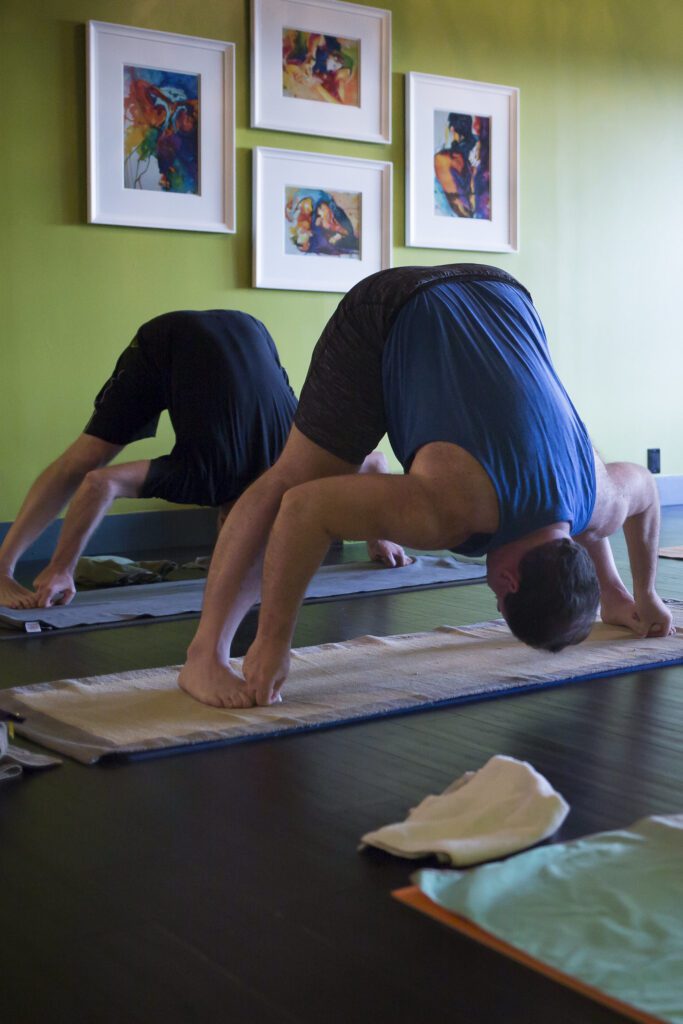
Ekam (Inhale) With your feet still 4-5 feet apart and parallel, and both hands to your hips, inhale and lengthen your spine. Be sure you keep your ribs pressing downwards as you work to lift your chest.
Dve (Exhale) Fold forward with a flat back, placing your thumb, index and middle finger around the big toe of each foot. Look up. Again inhale lengthening your spine, looking upward. Keep your feet parallel to each other and ensure that your toes are pointing straight ahead.
Trini (Exhale) Pressing your feet down and out, with arms straight, fold forward. Once folded, bend your elbows out to 90 degrees, keep your wrists straight and pull your toes forward with your gripped fingers as your press your feet down and out. Root down through the four corners of your feet, pressing down and out through the feet to engage your glutes to help support your body. Stay here five deep breaths. Engage mula bandha with each inhale. Gazing towards your nose (Nasagrai Drishti).
Chaturi (Inhale) Straighten your arms and look forward. Exhale here.
Pancha (Inhale) Place your hands to your hips and inhale back to standing. Be sure you press your hips forward and allowing your weight to stack naturally through space to return to standing. Exhale there.
As you practice these postures, pay attention to grounding your feet into the earth, and be sure to engage your back muscles to keep your chest open. As always, focus on deep breathing with sound while engaging your internal muscles.
Modifications
- Bending the Knees: If you have tight hamstrings or hip flexors, you can bend your knees slightly in any of the Prasarita Padottanasana variations. This can help reduce strain on the hamstrings and lower back, and allow you to focus on maintaining proper alignment. It also helps you find oppositions through your feet, which help you activate your hips and glutes to support your sacrum as you work to get stronger and more flexible in the posture.
- Narrowing the Leg Stance: If you feel unstable or uncomfortable with a wide leg stance, you can bring your feet closer together, making the stance narrower. This can help improve balance and stability, especially if you’re a beginner or have balance issues.
Remember to always listen to your body and practice within your own range of motion. It’s essential to work with a qualified yoga teacher if you have any specific concerns, injuries, or limitations to ensure that you’re practicing safely and effectively.
Tap here to watch a step-by-step tutorial video on Prasarita Padottanasana A-D
Prasarita Padottanasana A-D offer numerous benefits for the body and mind, including stretching and strengthening the lower body, promoting a healthy spine, calming the mind, improving digestion, enhancing balance and proprioception, and energizing the body. However, it’s important to practice with caution and make modifications as needed based on your individual needs and limitations. With proper alignment and mindful practice, Prasarita Padottanasana can be a beneficial addition to your yoga practice.
Keep Learning
❤️ If you would like to learn yoga with me online, you can do so through my YouTube channel: https://www.youtube.com/@yogawithkrista
Our mission is to help as many people as possible find wholeness in their lives through totally free, high quality yoga videos. We welcome all levels, all people, all bodies, all genders, absolutely everyone! SUBSCRIBE to the channel and join wholeness (Olotita) movement! ❤️
Yoga Tutorial Playlist:
❤️ Yoga is truly accessible to everyone! The hardest part is showing up. Tap here to access the Yoga Tutorial Playlist on Youtube.
About Krista:
I am a level II authorized Ashtanga Yoga teacher and I am passionate about sharing these teachings with all who wish to learn.
If you want to join me in person I teach daily classes at The Yoga Shala in Winter Park, Florida. I also offer virtual sessions in Yoga, Meditation, Breath-work, Nutrition, Life Coaching and Mentorship. Check out www.theyogashala.org for more details.
If you do not live in Central Florida and want to find an authorized teacher in your area, check out my teacher, Sharath Jois’ website, for a list of all teachers authorized and certified by his yoga centre in India.
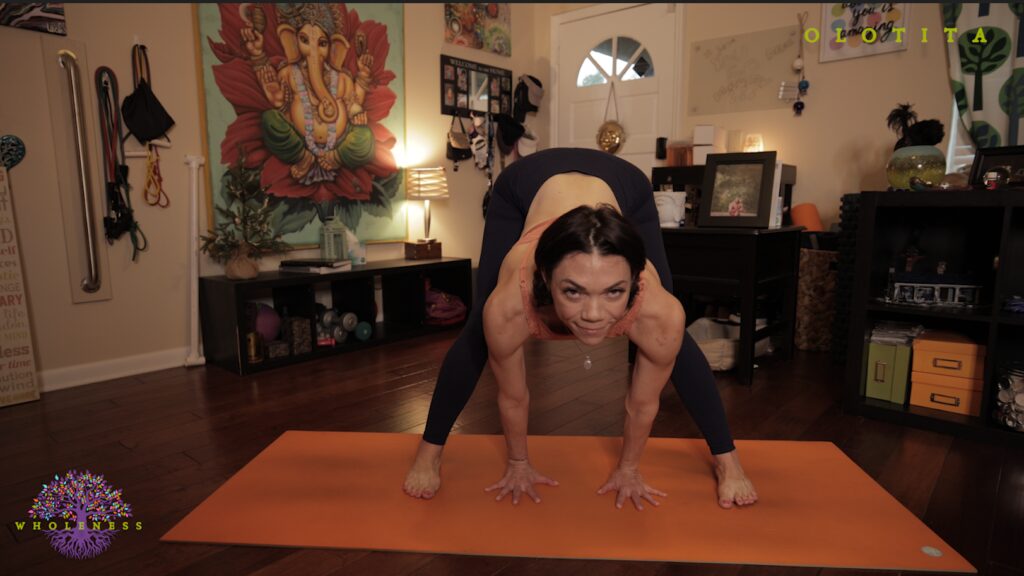
Stay in touch:
❤️Be sure to https://olotita.com/yoga-classes-in-winter-park-florida/newsletter/ to stay on top of local events and classes, Nysa products sales, new offerings, new products and more! ❤️
❤️We appreciate all your support. If you’d like to donate to our channel: Paypal
[email protected]. Please put “donation” in your message. Thank you.
❤️SHOP MERCHANDISE: Nysa Products
❤️CLASSES & PRIVATE INSTRUCTION: If you would like to book your spot for my upcoming group engagements or work privately with me on an individual basis please visit: www.theyogashala.org
❤️SOCIAL MEDIA: You can catch other content by following me on:
Instagram: @kristashirleyyoga
Instagram: @theyogashala_
Facebook: @theyogashala
Facebook: @KristaShirleyYoga
TikTok: @kristashirleyyoga
Twitter: @kristayogini
❤️For other inquires please contact: [email protected]
❤️Thank you for liking, subscribing, and sharing our videos!❤️
❤️ Namaste ❤️





